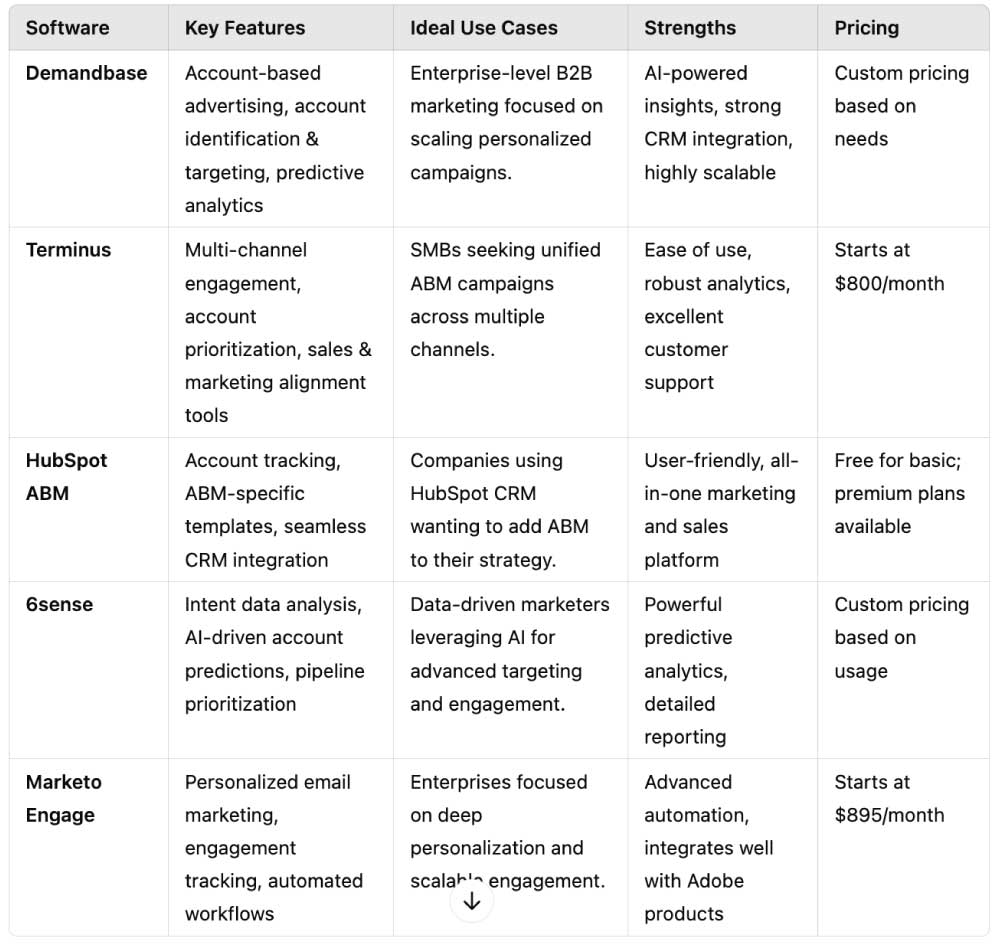Account-Based Marketing (ABM) Software is a specialized tool designed to help businesses identify, engage, and nurture high-value accounts with tailored marketing strategies. Unlike traditional marketing methods that cast a wide net, ABM focuses on creating personalized experiences for specific accounts, often leading to stronger relationships, higher ROI, and a more targeted sales funnel. This approach aligns marketing and sales teams to work cohesively toward common objectives, making ABM software an essential part of modern B2B marketing strategies.

Account-based marketing strategies target specific people and organizations rather than casting a more general net.

Below is a directory of account-based marketing software products. Before we get to the directory, let’s take a look at some of the features and use cases of some of the most popular account-based marketing software available. The chart below describes key features, ideal use cases, and other information that should give you insights into how account-based software is used, including implementing these features:

The video below, made by Eye on Tech, is a thorough guide to how businesses (especially enterprise businesses) can use account-based marketing to take a spear fishing approach to targeting potential clients instead of casting a wide net, which tends to be costly and have a lower ROI.
To become more familiar with account-based marketing software, it is useful to take a look at a use case that provides an example. Here’s one example.
Imagine a SaaS company targeting Fortune 500 enterprises. Using an ABM software platform like Demandbase or Terminus, the company can identify key decision-makers at a target account—such as a major retail chain—and tailor content, ads, and communication specifically to their pain points and business goals. For instance, the software might enable the delivery of personalized email campaigns, customized website experiences, or even tailored LinkedIn ads that address the retail chain’s need for improved inventory management. By focusing resources on high-value accounts, the SaaS company secures a contract that might not have been possible through generalized marketing efforts.
This real-world application highlights the transformative potential of ABM software in turning targeted accounts into loyal, long-term customers.
Provides a comprehensive suite for account identification, engagement, and measurement, integrating advertising, sales intelligence, and data management.
Utilizes AI and big data to uncover anonymous buying behavior, enabling personalized, multi-channel engagement with target accounts.
Offers account-based advertising, email signature marketing, and web personalization to drive engagement with key accounts.
Provides a range of marketing tools, including ABM features, to help businesses attract, engage, and delight customers.
Part of Adobe Experience Cloud, Marketo Engage delivers lead management, email marketing, and revenue attribution, supporting personalized engagement at scale.
There are several other software categories that overlap or compete with the account-based marketing software category. Here are some software categories that are similar to Account-Based Marketing Software. Understanding how ABM
Overlap: Both ABM and marketing automation software focus on automating marketing campaigns, lead nurturing, and engagement tracking.
Platforms like HubSpot, Marketo Engage, and Pardot offer marketing automation features that can be tailored for ABM strategies.
Overlap: Tools like Google Ads, AdRoll, or RollWorks specialize in targeted advertising and retargeting, a core component of ABM campaigns.
Some AdTech platforms have features that enable account-specific targeting, competing directly with ABM software.
Overlap: CDPs such as Segment or BlueConic aggregate customer data from various channels to create unified profiles for targeted marketing.
CDPs provide foundational data and insights that ABM platforms leverage for precise targeting.
Overlap: Platforms like ZoomInfo and Clearbit provide account intelligence and contact details for high-value accounts, often feeding into ABM workflows.
Lead generation software specializes in finding and qualifying accounts, an essential ABM step.
Overlap: CRMs like Salesforce and HubSpot store customer and account data, enabling sales and marketing teams to target specific accounts.
While CRMs lack the full ABM toolset, they integrate closely with ABM platforms and sometimes offer add-ons for account-based strategies.
Overlap: Sales enablement tools, such as Outreach or SalesLoft, help sales teams engage accounts effectively with personalized communications and insights.
Sales Enablement Software platforms focus more on the sales side but can replicate ABM’s one-to-one targeting capabilities.
Overlap: Tools like Optimizely or Dynamic Yield focus on customizing user experiences across websites, emails, and ads, similar to ABM platforms.
Personalization Software offers deep personalization capabilities, particularly useful in targeted marketing strategies.
Overlap: Platforms like Tableau and Domo deliver insights into account behavior and campaign performance.
While these tools focus on data analysis, they can support ABM by identifying high-potential accounts.
ABM software typically integrates seamlessly with CRM systems (e.g., Salesforce) and marketing automation tools (e.g., HubSpot, Marketo) to centralize account data and streamline workflows. This integration ensures that account insights, engagement histories, and campaign data are accessible to both sales and marketing teams, enabling coordinated efforts and consistent messaging.
ABM software utilizes AI and machine learning to analyze vast amounts of data, identify high-value accounts, and predict buying behavior. These technologies can detect patterns in customer engagement, forecast account readiness for outreach, and provide recommendations for the most effective marketing strategies. AI also helps in personalizing content at scale by dynamically adapting messaging to individual account preferences.
Intent data is a critical component of ABM software, providing insights into potential customer behavior by analyzing their online activities. For example, it can track searches for industry-specific keywords, content consumption patterns, or engagement with competitor websites. ABM software uses this data to prioritize accounts that are actively researching solutions, enabling timely and targeted outreach.
Account-based advertising involves delivering personalized ads to key decision-makers within target accounts. ABM software facilitates this by using IP-based targeting, cookie tracking, and data integration with ad platforms. Marketers can create custom audiences and launch hyper-targeted ad campaigns across channels like LinkedIn, Google, or programmatic networks, ensuring maximum visibility for key accounts.
Advanced analytics in ABM software provide in-depth insights into campaign performance, account engagement, and revenue attribution. Features like multi-touch attribution, predictive analytics, and account health scoring allow marketers to measure the effectiveness of their strategies and refine them. These analytics ensure that resources are focused on activities that yield the highest ROI.
Account-based marketing originated in the early 2000s as B2B companies sought more effective ways to engage with high-value accounts. The approach was formalized by organizations like ITSMA (Information Technology Services Marketing Association), which coined the term and provided frameworks for its implementation. ABM aimed to align sales and marketing efforts, focusing resources on a select group of key accounts.
ABM software began gaining traction around 2015 as companies like Demandbase, Marketo, and Engagio introduced specialized platforms to streamline ABM processes. The growing need for B2B companies to demonstrate ROI from marketing efforts and align with evolving buying processes further accelerated adoption. By the late 2010s, ABM software had become a critical component of B2B marketing strategies.